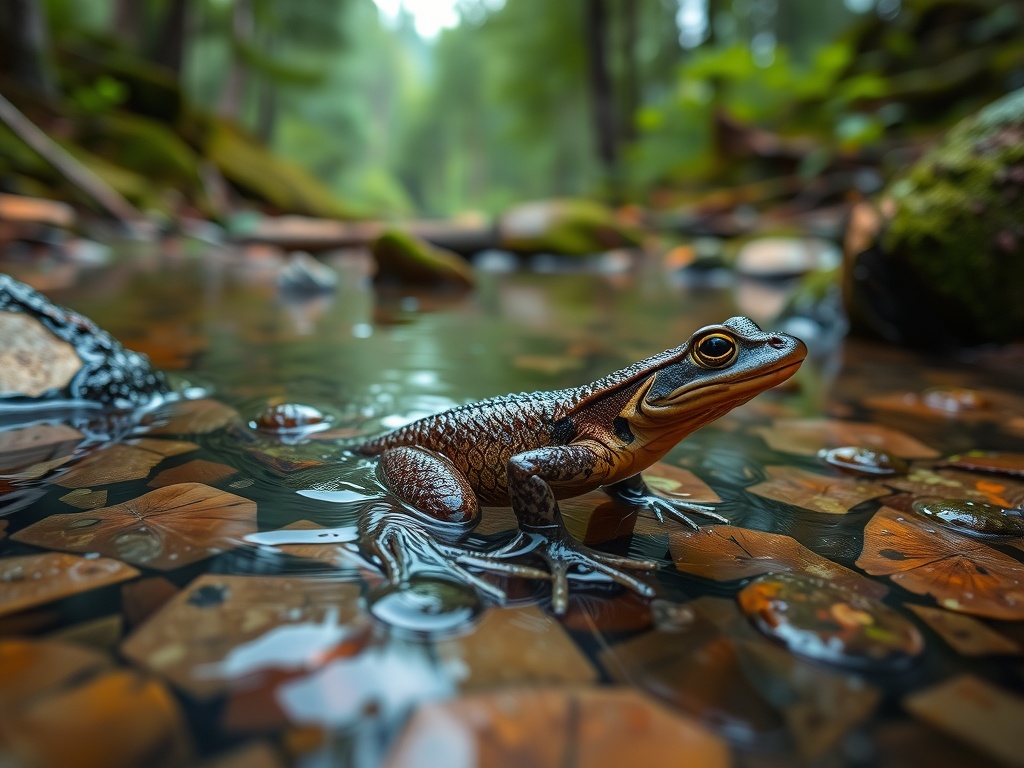
Carpathian Newt
Lissotriton montandoni

Meet the Carpathian Newt
The Carpathian newt is a slender, small amphibian native to the Carpathian Mountains of Central and Eastern Europe. Distinguished by its smooth skin, olive-brown coloration, and subtle orange underbelly with small dark spots, this species is well-adapted to cold, mountainous habitats. During the breeding season, adults migrate to clean, cool freshwater bodies such as ponds and streams, while outside breeding, they seek shelter in damp forests and under logs or stones. The Carpathian newt plays an important ecological role as both predator and prey in its environment, helping to control insect populations.
Classification
Amphibian
Habitat
Mountain forests, freshwater streams and ponds
Diet
Carnivore
Lifespan
6-10 years
Conservation
Least Concern
Weight
2-4 grams
📖Fascinating Facts
Egg-laying Habits
Females lay their eggs individually, attaching them to aquatic plants to protect them from predators.
Mountain Specialist
This newt is specially adapted to the cold, high-altitude environments of the Carpathian Mountains.
Colorful Belly
The Carpathian newt's bright orange belly with tiny dark spots serves as a warning sign to potential predators about its toxicity.
📋Detailed Description
The Carpathian newt (Lissotriton montandoni) is a small, slender-bodied amphibian, typically measuring 8–10 cm in total length, with females generally larger than males. Its dorsal coloration ranges from olive-brown to greyish, often with subtle marbling or darker flecks, while the ventral side is a distinctive orange to yellow, marked with small, irregular dark spots. The skin is smooth and moist, except during the breeding season when males develop a slightly rougher texture and a low, wavy dorsal crest that extends from the head to the tail. The tail is laterally compressed and ends in a fine filament, aiding in swimming. The head is relatively flat with a rounded snout, and the eyes are prominent with a golden iris. Limbs are well-developed, with four fingers on the forelimbs and five toes on the hindlimbs. Carpathian newts are primarily nocturnal, emerging at dusk to forage, and are secretive during the day, hiding under stones, logs, or leaf litter. Their life span in the wild is estimated at 6–10 years, and they are known for their remarkable site fidelity, often returning to the same breeding ponds year after year.
💡 Did you know?
Unlike some other newts, the Carpathian newt often hybridizes with the smooth newt where their ranges overlap, producing viable offspring.
🔬Research & Sources
Wikipedia Summary
The Carpathian newt, or Montandon's newt, is a species of salamander in the family Salamandridae found in Czech Republic, Poland, Romania, Slovakia, and Ukraine.
Last Modified: 2/8/2025
🎭Behavior & Social Structure
Carpathian newts are solitary outside the breeding season, exhibiting territorial behavior in their terrestrial habitats. They are primarily crepuscular and nocturnal, emerging at twilight to hunt for small invertebrates such as insects, worms, crustaceans, and mollusks. Their hunting strategy involves slow, deliberate movements and sudden lunges to capture prey with a quick flick of the tongue. During the breeding season, they become more gregarious, congregating in aquatic habitats where males display elaborate courtship behaviors, including tail fanning and body undulations to attract females. Outside the breeding period, they are highly secretive, spending most of their time in moist microhabitats to avoid desiccation. Carpathian newts are known to exhibit homing behavior, navigating back to their natal ponds using olfactory and possibly geomagnetic cues.
👶Reproduction & Life Cycle
Breeding occurs from late April to early June, coinciding with snowmelt and increased water availability in mountain ponds and slow-moving streams. Males arrive first at breeding sites and establish small territories. Courtship involves a series of ritualized displays: the male approaches the female, fans his tail to waft pheromones, and performs a 'tail-waving' dance. Fertilization is internal; the male deposits a spermatophore, which the female picks up with her cloaca. Females lay 80–250 eggs singly, attaching them to submerged vegetation or detritus. The eggs hatch after 2–4 weeks, depending on water temperature. Larvae are aquatic, with external gills and a well-developed tail fin, and undergo metamorphosis after 2–3 months. There is no parental care post-oviposition, but females may select oviposition sites that maximize offspring survival.
🛡️Adaptations & Survival
Carpathian newts are well-adapted to the cool, humid environments of the Carpathian Mountains. Their smooth, permeable skin facilitates cutaneous respiration and moisture absorption, critical for survival in both aquatic and terrestrial phases. The species exhibits seasonal habitat shifts: aquatic during breeding and terrestrial otherwise, allowing them to exploit different food resources and avoid aquatic predators. Their cryptic coloration provides camouflage among leaf litter and moss. Physiologically, they can tolerate low temperatures and have a degree of freeze tolerance, enabling them to survive in high-altitude habitats. The ability to regenerate lost limbs and tails is a notable adaptation among newts, aiding survival after predatory attacks.
📚Research Sources
🎨Cultural Significance
The Carpathian newt holds limited direct cultural significance but is sometimes featured in local folklore as a symbol of clean mountain streams and healthy forests. In some Carpathian communities, newts are regarded as indicators of environmental purity, and their presence is associated with unspoiled natural habitats. There are no known traditional medicinal or culinary uses, but their striking appearance and secretive habits have inspired local myths about magical or elusive forest creatures.
🔬Recent Research & Discoveries
Recent genetic studies have clarified the phylogenetic relationships within the Lissotriton genus, confirming the distinct status of L. montandoni and revealing historical hybridization with the smooth newt (Lissotriton vulgaris) in areas of sympatry. Ongoing research focuses on the species' responses to environmental changes, including climate-driven shifts in breeding phenology and range. Studies on their skin microbiome are investigating natural defenses against chytrid fungus. Population genetics research is also being conducted to assess gene flow and the impact of habitat fragmentation.
🎥Wildlife Videos

In the Wilderness of the Carpathian Mountains | Wild Slovakia | Free Documentary Nature
In the Wilderness of the Carpathian Mountains | Wild Slovakia | Wildlife Documentary Watch 'Croatia's Secret Animal Paradise' ...
Free Documentary - Nature

Story of the Eastern Newt - A Nature Documentary
Welcome back to the Salamander Wilds! Your certified Herpetologist here, back with another video! This time, I explore the life of ...
The Salamander Wilds

The Baltic | Survival in a Pristine Ecosystem | Animal documentary
Welcome to "The Baltic | Survival in a Pristine Ecosystem", a captivating wildlife documentary that transports you to the serene yet ...
WILD NATURE - Nature animal documentary

Great Crested Newt Documentary
Documentary on the great crested newt and the work of Wildwood Trustee & Director of the Durrell Institute of Conservation ...
Wildwood Trust

Wild Carpathia | Episode 1: Transylvania | Free Documentary Nature
Wild Carpathia - Episode 1: Transylvania | Nature Documentary Watch 'Wild Carpathia - Episode 2' here: ...
Free Documentary - Nature

INTO THE CARPATHIAN WILD (trailer)
European wildlife is threatened like never before... its last refuge... the Carpathians. Of all the mountain ranges in Europe, the ...
Arolla Film
🌍Habitat Information
The Carpathian Newt typically inhabits Mountain forests, freshwater streams and ponds environments. Carpathian Newts have adapted to their environments with specialized features and behaviors.
Primary Habitat:
Mountain forests, freshwater streams and ponds
More detailed habitat information will be available soon.
🛡️Conservation Status
The Carpathian Newt is currently classified as Least Concern. Conservation efforts are crucial for preserving this species for future generations.
Common Threats:
- 🏠Habitat loss and fragmentation
- 🌡️Climate change impacts
- 🎯Hunting and poaching
- 🏭Human-wildlife conflict
⚠️Threats & Conservation Challenges
Although currently listed as Least Concern by the IUCN, Carpathian newt populations face several localized threats. Habitat loss and fragmentation due to logging, agriculture, and infrastructure development reduce suitable breeding and foraging sites. Pollution of breeding waters by pesticides, fertilizers, and industrial runoff poses risks to eggs and larvae. Climate change may alter hydrological regimes, affecting the availability and duration of breeding habitats. Introduced fish species and the spread of chytrid fungus (Batrachochytrium dendrobatidis) are emerging threats. Despite these challenges, the species remains relatively widespread and stable, but continued monitoring is essential.
🔬Scientific Classification
Scientific Name
Lissotriton montandoni
Classification Hierarchy
🔍 About Taxonomic Classification
Taxonomic classification is a hierarchical system used by scientists to classify and organize living organisms based on shared characteristics and evolutionary relationships.
The system moves from broad categories (Kingdom) to increasingly specific ones, with each animal's scientific name typically consisting of its Genus and species.
📝Community Notes
Share your observations and insights about the Carpathian Newt with our community of wildlife enthusiasts.
Join Our Community
Sign in to share your observations and connect with fellow wildlife enthusiasts.
Sign In to ContributeNo community notes yet
Be the first to share your observations about the Carpathian Newt!
Explore Carpathian Newt
Select a tab above to learn more about this amazing animal.
📸Photo Gallery
No photos available for this animal yet.
🌟Discover More Wildlife
Continue your journey of discovery with more fascinating animals from our database
